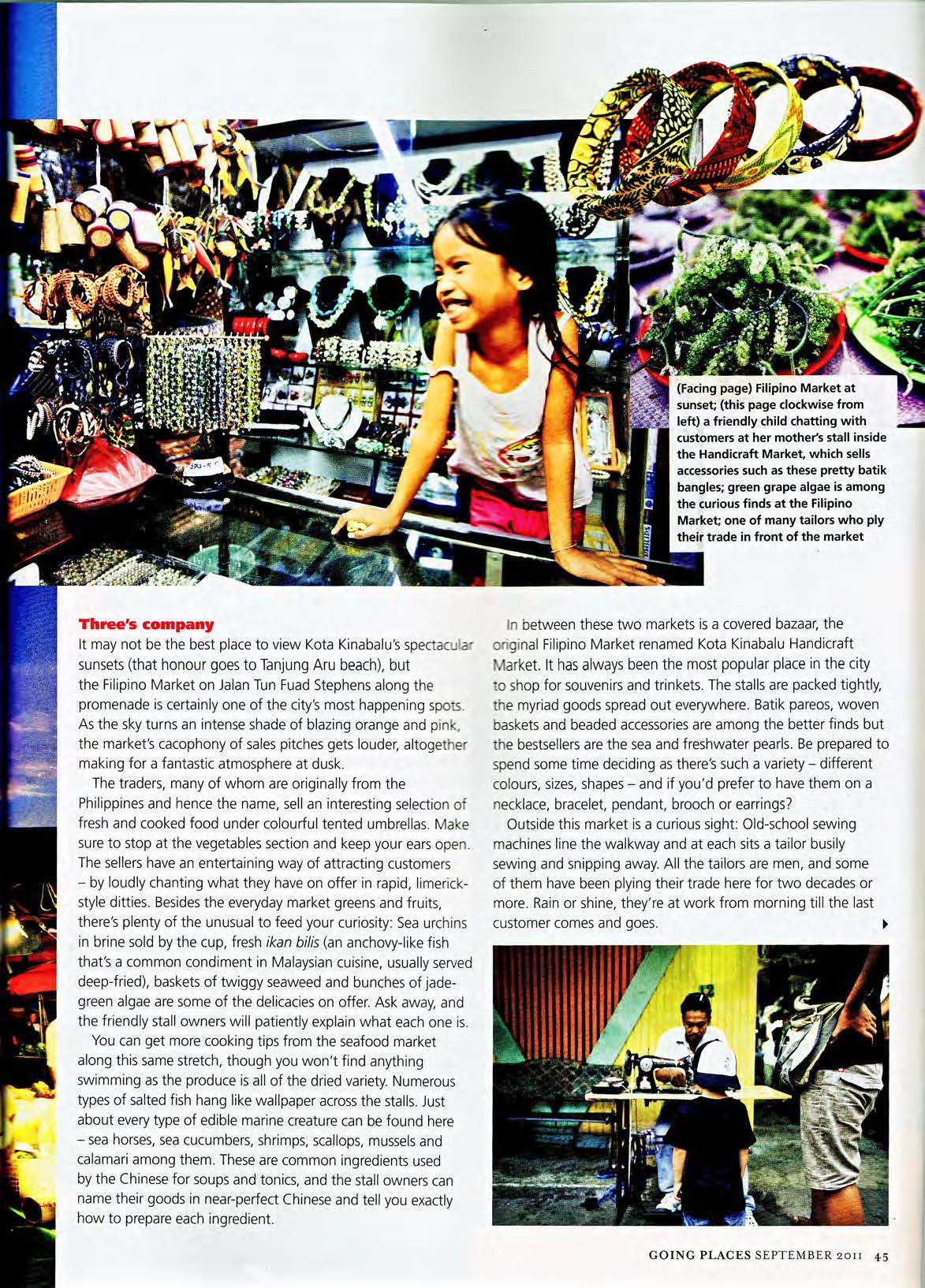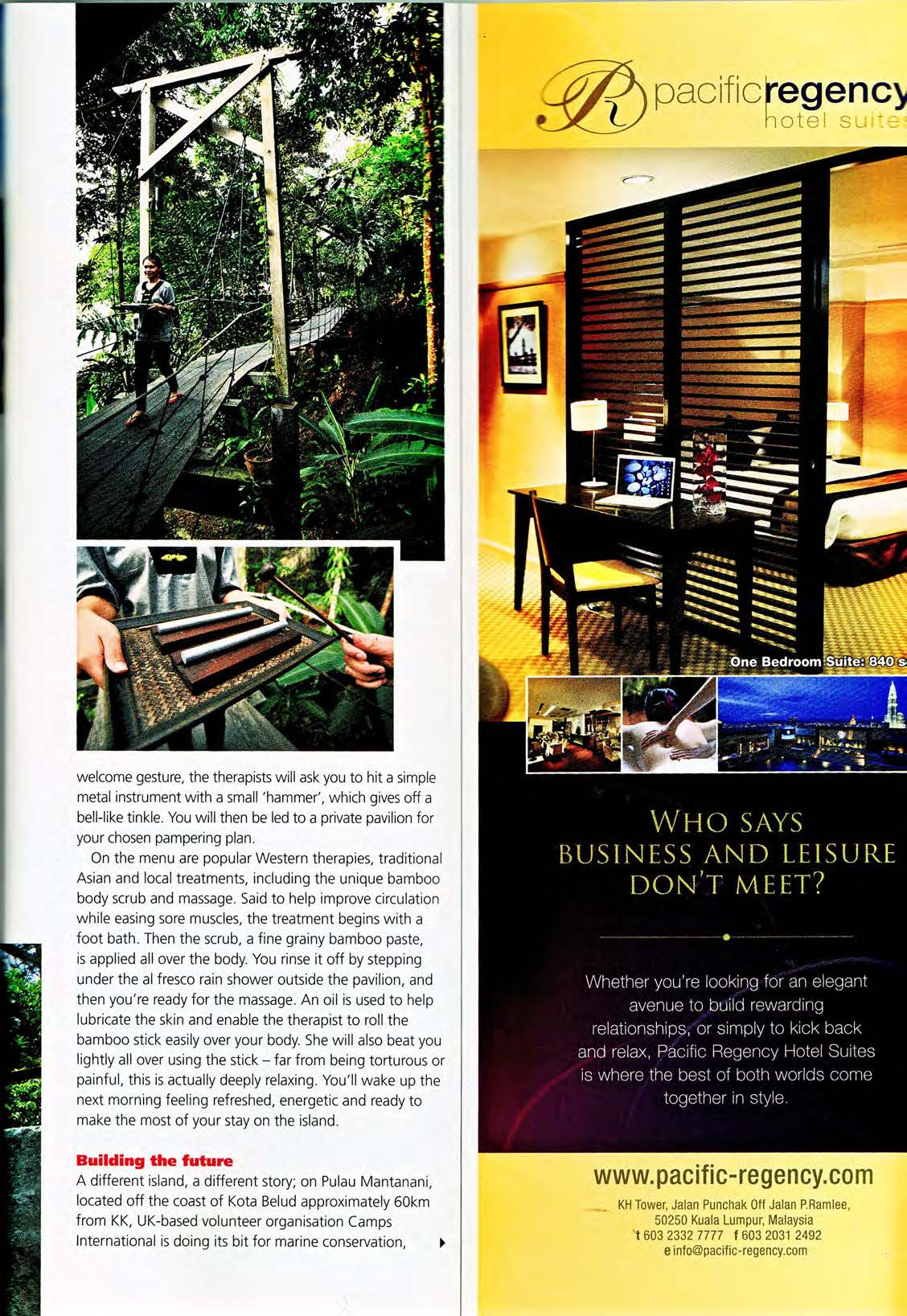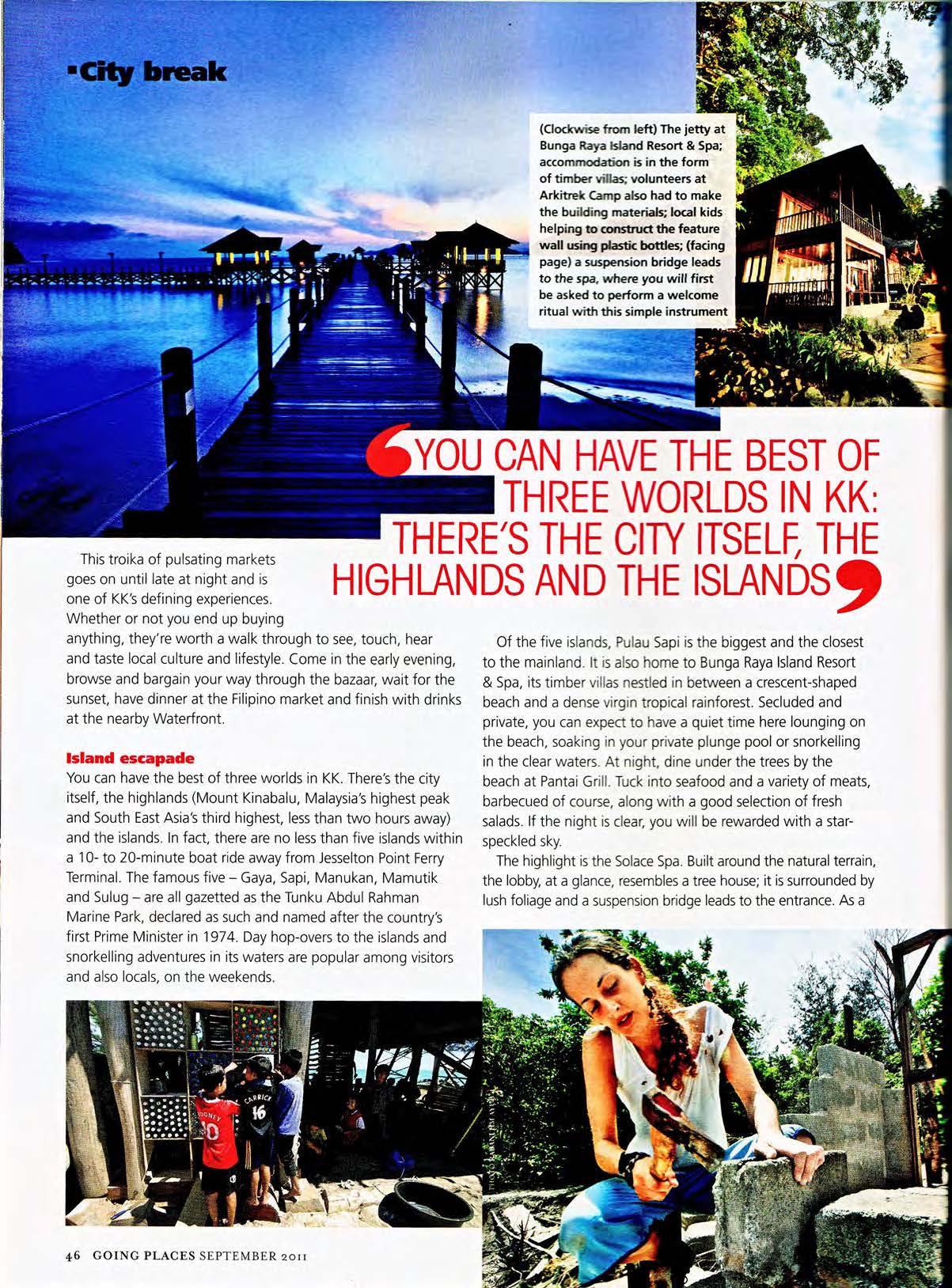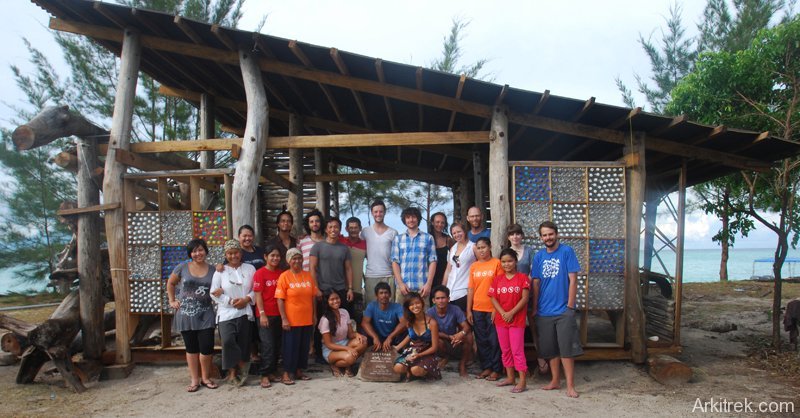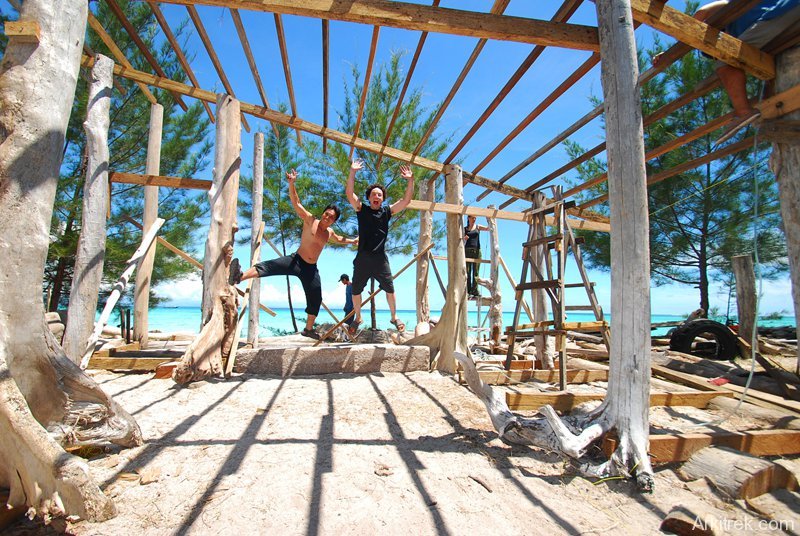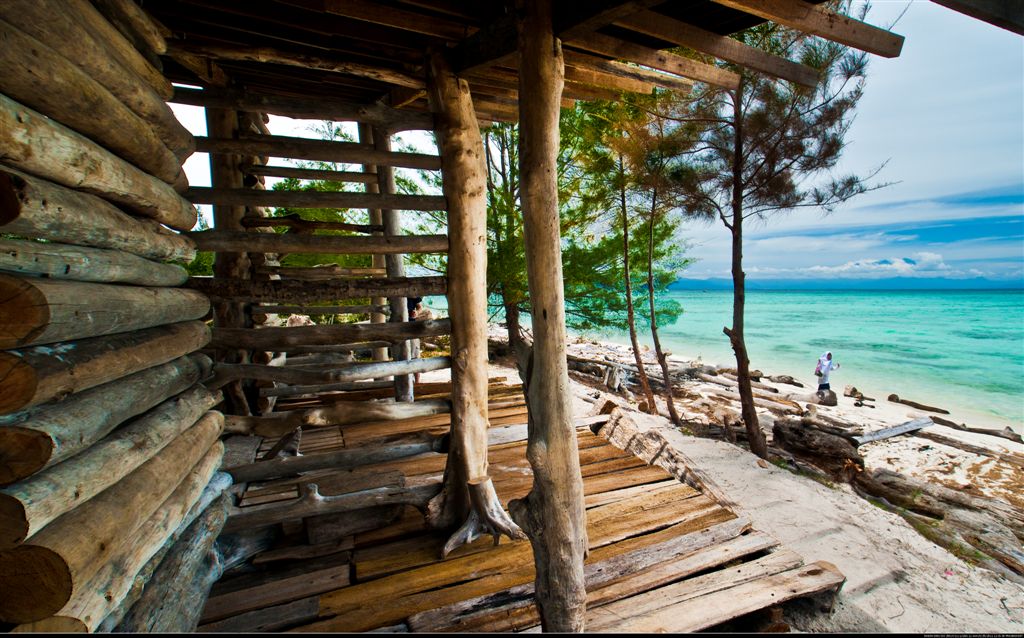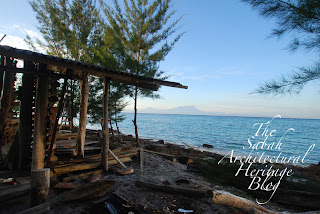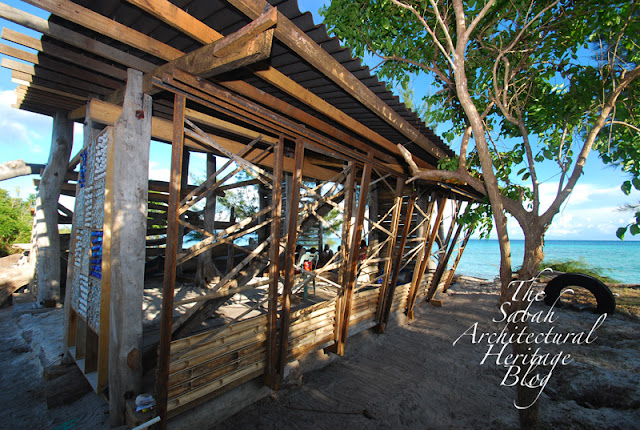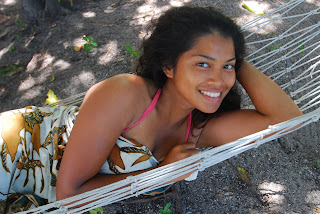The Star: Designs that matter
The Star, Malaysia
Saturday July 16, 2011
Designs that matter
By LEONG SIOK HUI
Read the original article
A team of budding architects and design professionals picks up construction know-how and ruminates on why design matters at a design-and-build camp in Sabah.
After seven years of slogging in architecture school, followed by 2½ years of designing building after building, David Thomas Arnott was on the verge of burning out.
“You spend so much time in university working on amazing projects. Then you start working and get caught up in the rat race. I wanted to do something meaningful, on a smaller scale, but with instant impact,” said Arnott, 26, who works with an Edinburgh-based firm.
So in May this year, Arnott signed up for a three-week architectural camp on Mantanani island, off the northwest coast of Sabah. Arnott was one of five paid participants taking part in Arkitrek Camp 2011. Open to architecture students and design professionals, the Camp provides participants with a real client and a very real design brief.
Over 21 days, participants are expected to design and construct a building from scratch.
“The idea of the camp is to bridge the gap between theory and practice. In most architecture schools, students never get a chance to build a single building,” explained UK-registered architect Ian Hall, the brain behind the Camp.
Hall has been practising architecture in Malaysia since 2004. His design consultancy, Arkitrek Sdn Bhd, tends to focus on rural projects and has worked with clients like Borneo Rainforest Lodge in Danum Valley and Bornean Sun Bear Conservation Centre near Sandakan.
“The Camp reflects Arkitrek’s philosophy of working responsibly in natural areas and building capacity for rural communities to implement a sustainable design,” explained Hall, who added that urban architecture didn’t cut it for him.
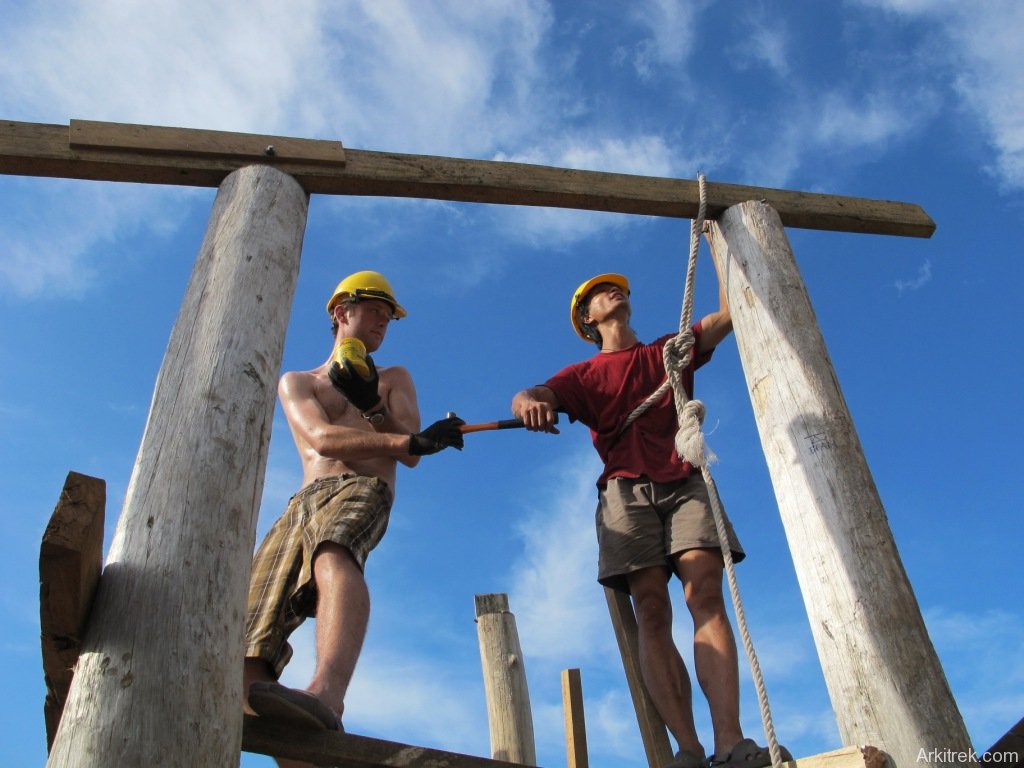 Will Smith and Teng Quan Zee putting up the first of the roof rafters sawn from driftwood.
Will Smith and Teng Quan Zee putting up the first of the roof rafters sawn from driftwood.
The context
At the inaugural Camp this year, the client was UK-based volunteer travel organisation, Camps International (CI). CI’s design brief was for a marine learning centre that doubled up as play area and community meeting spot for 900 Mantanani inhabitants. The idea was to convince the islanders of the importance of preserving the environment.
“Our ultimate aim is for the community to be stewards of their own marine environment and to generate income for the locals to raise their standard of living,” said Melanie Chu, CI’s Camp Borneo general manager.
The Arkitrekkers (as participants are called) were mostly design students and graduates from Malaysia, the US and the UK.
“This type of project, where you solve community problems via architecture, is where I feel I can really help people through design,” said participant Chew Pui Cheng of Petaling Jaya.
Chew, 21, completed her architecture diploma at Taylor’s University and is continuing her studies in Scotland this September.
“You also get to work with design students from various countries,” she said.
Led by camp facilitators Sarah Greenlees of the UK and Daniele Elian Cohen of the US, the team started out by familiarising themselves with the vernacular building styles of Kota Kinabalu, then interviewing CI’s Mantanani camp manager Aida Rahman and the village headman, Albi Alad, before coming up with a design.
They settled on a building with a mono-pitched roof, fashioned mostly from driftwood and sawn timber.
More than just a glorified hut, the structure would boast 4.5m high driftwood columns. Additional features included a deck overlooking the sea, openings for cross-ventilation and a wall made from recycled plastic bottles.
Driftwood of various shapes and sizes would be stacked up to make a wall to show off their beauty.
The team spent the first few days looking for massive driftwood from the sea.
“Thanks to the roof sheets sponsored by Onduline, the total budget only came to RM6,000, including tools,” said Hall.
Since the building was to be strategically located between the two villages on the island, the team incorporated a pathway that sliced through it.
“The idea is to make a thoroughfare for the school kids on their way to school,” explained Greenlees.
A counter would be used as a shop for selling knick-knacks, and there were provisions for living space for the community to hang out in.
On top of what they could complete within the three weeks, the team also decided to leave behind a set of drawings that would allow future Arkitrekkers and CI volunteers to add to their building.
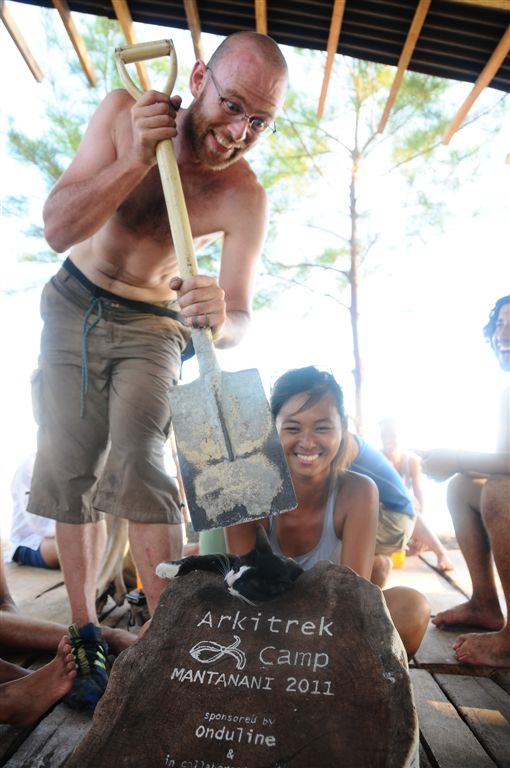
Founder of design firm, Arkitrek Sdn Bhd and Arkitrek Camp, Ian Hall.
Hands-on learning
Over the weeks, the team had to return to the drawing boards several times to make adjustments as required.
“When you study architecture, you fall into a trap where you do a drawing and it gets sent away. Building with our bare hands allows us to understand how things are built and makes us a much more well-rounded architect,” Arnott said.
He had initially worried that the camp might be too theoretical and that the design discussions would turn into ego fights. But that never happened.
“It’s been great fun on site! I’m impressed because when you look at the size of the huge columns, it’s almost medieval because we don’t have a crane and we did everything by hand,” grinned Arnott.
One participant, Michelle Louise Martin, said she studied construction for two years before university but she only really learned the nuts and bolts of construction at the Camp.
“On previous site visits, if I didn’t like something, I’d say to the contractor, ‘Change that please!’ Now that I know what they have to go through, I’ll be nicer next time,” chuckled the 23-year-old who worked as a conservation architect for three years whilst finishing her degree.
Martin admitted she was homesick and suffered from culture shock in her first week here.
“The heat, the squatting toilet and the food, going from meat and veggies to rice and noodles all the time … I struggled with all that at first,” the soft-spoken Martin revealed.
It was her first time away from home alone, and not having Internet or mobile phone reception on the island didn’t help.
“I wish I could just speak to my mum over the phone. But everyone’s been absolutely amazing. We’re getting on great and laughing a lot,” she added.
A senior at the University of Oregon, William Frederick Smith snuck out of college in the middle of spring semester to join the Camp. He said he liked working with reclaimed materials and thinking about environmental impact.
“My university has always been a green-oriented school but we talk about sustainable design on a big scale, like solar technology,” said Smith, 21.
“Here, we do simple but necessary things like rainwater harvesting and see it being applied.”
The Arkitrekkers got a real kick out of collaborating with locals like Albi and his brother, Hashim, who handled the chainsaw and dished out tips on using local materials in the best possible way.
“I’m impressed by how focused and motivated the team is,” said Albi, 57, a full-time CI employee who builds houses and boats for a living.
“They pick up things fast, and I actually learned a lot from them despite my 20-year experience in construction.”
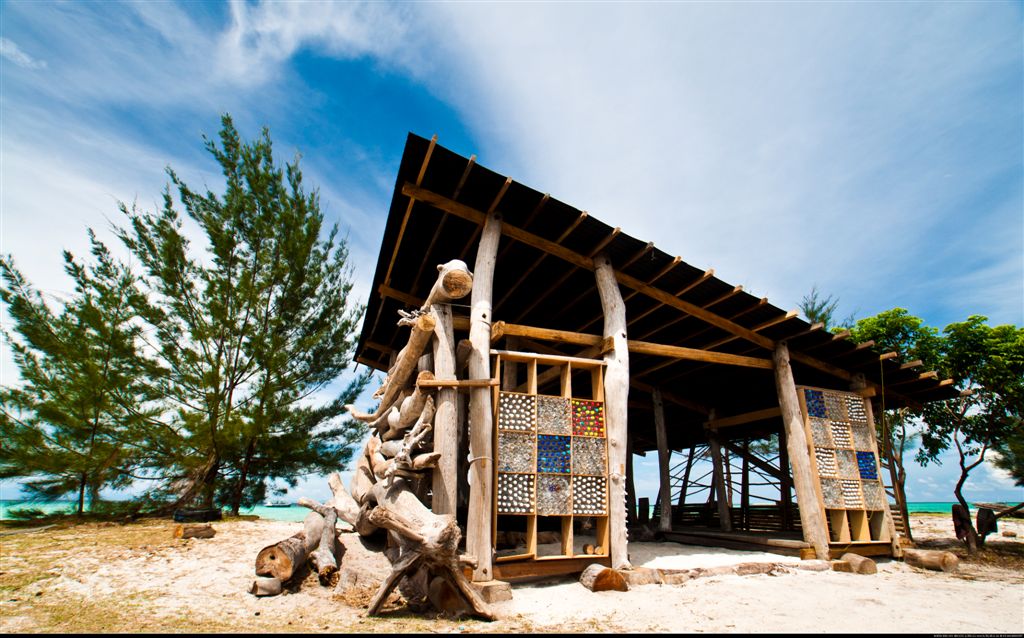 The completed structure will be used as a marine awareness centre and a community space for Mantanani islanders.
The completed structure will be used as a marine awareness centre and a community space for Mantanani islanders.
Epiphanies
Like most of the Arkitrekkers, Smith experienced his own design epiphany of sorts.
“I realised you can make good architecture without having to be a stressed-out desk monkey. I could either follow the profession, get huge urban projects and solve urban problems. Or step outside the system, do smaller community projects and forge personal relationships with clients that result in meaningful projects that stay with you, regardless of what you started or ended with,” Smith said.
“Yes, after this Camp, I believe architecture should not just be about providing space, but making that space important to its users and bringing together communities,” Martin chipped in.
By the end of the three weeks, the team had completed over 90% of the building. The learning centre is now fully functional except it still requires a counter for the shop and a lockable store.
For Chew, the Camp left lasting memories.
“The unforgettable moments – when the local kids worked alongside us, taking turns to bore holes, putting up the recycled bottle wall, collecting sand and sawing wood, or when they dived into the huge hammock and collapsed into a pile of giggles, or clambered all over the unfinished driftwood wall. Our building has worked its magic,” she enthused.
Arnott said the Camp had reinvigorated his passion for architecture.
“The team’s passion for architecture is infectious. I’m definitely putting more energy into my design and not giving up so easily,” Arnott said in an e-mail two days after returning to Scotland.
Smith summed it up perfectly: the Camp “is a down-to-earth project and process, a group of people from around the world, a beautiful context to explore.”
Arkitrek Camp2 will be held from Jan 4 to Feb 4, 2012 on Mantanani Island, Sabah. For details, check: https://arkitrek.com/arkitrek-camp/
Arkitrek Camp2
Arkitrek Camp2
4th January – 4th February 2012, Mantanani Island, Sabah.
The Arkitrek Camp is for students, graduates and professionals in the construction industry. For students it is a chance to experience the construction process first hand and to learn that what you design must actually be build-able. For professionals perhaps it is a chance to refresh your enthusiasm for your profession and commitment to sustainable use of natural resources
“This truly has changed my perception of architecture. I didn’t think it would, and I’m not one for radical shifts in my thinking. However, being back with people that are so passionate about design is infectious. The greatest thing about the camp is that I have rediscovered my love for architecture and I am going to work very hard to let this inform all my work back in Scotland.” David Arnott, Camp Participant May 2011
The Arkitrek Camp gives a team of 10-15 participants a real project brief in an exotic location in Malaysian Borneo. The program is intense because in a short period of time the team must write their design brief, conduct socio-environmental surveys, complete the design process and build their proposals. The experience will bridge the gap between theory and practical application, giving participants new skills, confidence and inspiration. All projects are sourced to complement the Arkitrek philosophy of working responsibly in natural areas and building capacity for rural communities to implement sustainable design.
A typical program will be to design and build infrastructure for community based tourism operations. This includes introducing sustainable design principles of passive design, responsible materials specification and sustainable use of natural resources. Projects may also contribute to environmental conservation programs, such as the May 2011 Arkitrek Camp which built a Marine Conservation Centre.
INCLUDED
• Arrival and Departure transfers
• Orientation & Safety briefs
• Fully staffed camps and local guides
• All course material and facilitation by experienced staff and guest tutors
• Full board accommodation throughout (traditional style buildings and tents)
• Unlimited Drinking water in camps
• Project Funds, materials and project coordination
• Emergency management plan
• Risk assessments for all activities and locations
________________________________________
NOT INCLUDED
• International and domestic flights
• Personal spending money
• Arrival and departure fees into Malaysia (Normally free but can depend on nationality/passport held)
• Insurance
• Vaccinations
• Personal equipment
• Drinks other than drinking water provided
• Personal laundry
• Tips or gratuities
• Meals other than those provided
________________________________________
COST The cost per person for this trip is GBP £1650 per person. This is based on a minimum team size of 8 and a maximum of 15.
Not yet ready to committ? enquire here for a detailed project brief and itinerary. Leave your number if you would like us to contact you by phone.
Sample Itinerary
The program itinerary is designed to provide an appropriate balance between teambuilding, design, research and construction.
Teambuilding stage – Arrive by midday in Kota Kinabalu (KK) and transfer to Camp Kipouvo, a community owned hostel in a picturesque village 30 minutes drive from the airport. After lunch and a welcome by Arkitrek Camp staff there will be an opportunity to engage in sporting and cultural activities with the local community. This day is a chance to get to know both your fellow Arkitrek Camp participants and the friendly Sabahan people. The following day will feature an architectural tour of Kota Kinabalu including lunch at a local restaurant. This day will conclude with sketching exercises and talks from local experts on architectural heritage and environmental conservation issues. Teambuilding activities will extend into the design stage.
Design Stage – The team will start early for the scenic drive to the project site. On arrival there will be an orientation briefing by the hosts plus a design brief discussion with the client and stakeholders. This stage is characterised by a series of workshops to explore the design brief and concept design ideas for the Arkitrek Camp project work. The workshops will be facilitated to encourage participants to link and connect ideas and build on each other’s contributions. The process will be guided by Arkitrek staff and guest facilitators. The final Bill of Quantities will be produced as early as possible in order to permit delivery of additional materials from the mainland in good time prior to construction. Final construction sequencing, risk assessments and method statements will be produced prior to construction
Research Stage – Time for research will be interspersed with other stages of the project and will include physical surveys of the site plus socio-economic surveys of the local population on subjects relevant to the project work. For example; if the project involves rainwater harvesting, the team will research local attitudes and solutions to freshwater resource management. On longer camps (more than 3 weeks) there will be a chance to take a break from the project site and complete a design charrette in the urban environment of Kota Kinabalu. Research time may also be used to run English classes with local school children with a design and/or sustainability theme.
Construction Stage – This is the meat of the program, during which the team will work alongside other Camps International guests and members of the local community. They will have to problem solve as they come up against technical issues and will gain experience from working with local tradesmen of varying levels of ability, experience and spoken English. The design will constantly have to be reviewed against progress and reality. Time is short for the construction so everyone will be expected to muck in with the aim of completing the project before their departure. By the end of the project, if all has gone to plan then there will be small jobs to finish off before an opening ceremony involving the camp and community with an official commissioning of the structure. Before the final party the team need to ensure that any outstanding work or future plans are clearly outlined and recorded for future teams to pick up and carry on where necessary.
Close – On the last morning the team will bid farewell to the project site and their new friends amongst the community and head back to civilisation with all its trappings! There will be a final farewell celebration dinner during which the team will be able to reflect on their achievement and look forward to new challenges, not before a little singing and dancing however.
Related posts
%RELATEDPOSTS%
Arkitrek Camp – Mantanani island 2011 (Conclusion)
Arkitrek Camp – Blog series by Richard Nelson Sokial (Part 5 of 5)
Original post can be found at the Sabah Architectural Heritage Blog
Just a typical morning on Mantanani island…
We had two days left to finish the MCP Learning Centre (the official name for Albi’s Chicken House).
It was crunch time – we knew it and everyone had their pokerface on as we silently ate our breakfast.
The Arkitrekkers had put up the roof the night before. Today, we had to finish the bottle wall, slanting bamboo wall elevation, floors and the massive driftwood wall on the east elevation.
Sarah’s illustrations of the interlocking driftwood wall. The boys joked that the drawings looked like trees in compromising positions.
“Kamasutra for trees”. LOL.
The two gappers had to leave the island early. Farewell, Jack and David B – thank you so much!
…but Ian came back and we were joined by Anna and Fraser, friends of David A. from UK.
Being put in charge of completing the bottle walls, I was feeling a bit under pressure. Albi – our key construction guy and expert with the chainsaw, had taken ill and was not able to cut the timber pieces that I needed for the original bottle wall design.
Pieces of leftover plywood from the camp’s previous projects were to be used instead of sawn planks.
This meant that the original wall design had to be simplified.
Meanwhile, Fraser, Anna, Pui Cheng and Michelle were cutting bamboo and figuring out how to put the slanted wall frames together.
The boys – Zee, David and Daniele were working hard on completing the building’s raised timber decks, while Pui Cheng and Ian were deciding how to put the driftwood wall together. Will was busy hammering pieces of driftwood onto the posts to complete the elevation facing the sea while Tina was working with Albi to drill the metal brackets holding the slanted walls.
Zee, David A and Will helping Ian and Hasheem lift a driftwood log into place.
Come noon and the Arkitrekkers were 80% finished with the building. The kids from Albi’s village had come out and watched with curious fascination as the Arkitrekkers raced against the clock to get the building done.
I saw an opportunity to utilize their little hands and roped in the kids to help complete the bottle walls. Giving clear instructions to them, the Mantanani children – led by Idham, Fadli and little Epot formed a mini crew of bottle outsourcers, bottle washers and bottle stuffers – as we systematically filled up the walls with plastic bottles that had been found on the beach and collected by the volunteers at Camp Mantanani.
The island kids were extremely enthusiastic about being part of this project – and I believe that it gave them a better sense of awareness, ownership and pride over this building – that would be handed over to them once the Arkitrekkers were gone.
The artistic effect of the bottle wall is a way of conveying new ideas of how the Mantanani people could make something pretty out of stuff they would have normally thrown away.
(Click to enlarge photo)
Aesthetically pleasing…but at the same time scary – just imagine how many discarded plastic bottles are thrown into the world’s oceans each day? Something to think about.
Everyone loved the hammock that Michelle designed and made. Bravo!
Meanwhile, the driftwood wall was finally finished and as the final reinforcing steel nut was screwed in, the kids had already started to climb onto the wall like a jungle gym.
Later, the bamboo walls that Fraser and the girls made were installed. The walls worked worked perfectly and were very comfortable to rest against.
We finished the timber deck floor just as Camp Mantanani’s staff showed up with cakes and tea.
Food!
Hooray, we finished the building!
Albi’s Chicken House was now officially completed! Well done Arkitrekkers!
That evening, the whole group celebrated their first night in Albi’s Chicken House with rice, barbecued chicken and lamb. Aida was the main chef. We made a huge bonfire from the pieces of rotten driftwood that we had cleared from the site.
Later, Aida took out a laptop and we looked at the photos showing the development process of the building that we had just built.
The finished building was kinda awesome actually.
After dinner, some of us decided to sleep in Albi’s Chicken House instead of our regular hammocks at camp. It rained heavily that night, the heaviest that we had ever experienced in our two weeks on the island. I guess it’s the universe’s way of testing our building. LOL.
Note: It was nice to find out later from Ian that Albi had commented that he had found a genuine appreciation for the Arkitrekkers and said he even learnt a few things from us as well. Hasheem had already booked his spot to nap in Albi’s Chicken House, and Mel was elated that Camp Borneo now had a proper place to conduct activities on Mantanani.
The building would be the first phase of Camp Borneo’s collaboration with Arkitrek, the next being an extension to the building with a shop for selling local island products such as driftwood sculptures, etc. I can already foresee Albi’s Chicken House as a meeting point for not only Camp Borneo’s volunteers but also for a ‘bridge’ for the two village communities living on the island.
Saying goodbye to Albi’s Chicken House…
Leaving Mantanani the next morning, we took our final photos as remembrance of the Arkitrek Camp experience. While several of us will have the chance to come back and see how the building has matured over time, some of the participants may never be able to visit this building again.
I am posting up my notes as a shout out to those awesome individuals of the first Arkitrek Camp, to remind them from time to time of what we achieved as a team – and that when enough like-minded people get together, we can make a difference in the world we live in.
It was a pleasure and honour to have been part of the first Arkitrek Camp and my salutes to everyone who was involved in it; Arkitrek Founder Ian Hall, Melanie Chu, Sarah Greenlees, Daniele Cohen, Pui Cheng (who never got called by her first name Vivian), Zee, David Arnott, Will Smith, Tina Celestial, Kitler the cat, Michelle Martin, David Beattie, Jack Allcock, Anna and Fraser, Yanti Saman, Albi and family, Hasheem, members of the Malaysian Police force on Mantanani (who helped us pull most of the heaviest driftwood) and last but not least the awesome Aida Rahman and her ukelele.
Three cheers for Arkitrek Camp
Related posts
%RELATEDPOSTS%
Arkitrek Camp – Mantanani 2011 (Part 4)
Arkitrek Camp – Blog series by Richard Nelson Sokial (Part 4 of 5)
Original post can be found at the Sabah Architectural Heritage Blog
Little by little, the Marine Conservation Programme Learning Centre building (the Arkitrekkers refer to it as Albi’s Chicken House) starts to take shape.
The absence of sporadic BUUURP! sounds around the vicinity of Camp Mantanani was an indication that Ian Hall had gone back to Kota Kinabalu on official business for a few days.
Meanwhile, I returned to the island with two gappers from UK – Jack and David B. The boys were fresh hungover fresh from their stay at Tinangol village in Kudat and were looking forward to doing something interesting during their stay at Mantanani.
In my absence, the rest of the Arkitrek Camp’s team had completed the building’s foundation and post structures – and were looking to putting up the rafters as soon as possible.
Living on an island for 2 weeks and working in a construction site doesn’t give anyone a lot of room to be glamorous.
Take Tina for example.
From this…
…to this. Hahaha.
Pui Cheng, on the other hand, was all business.
From this…
…to this!
She was in charge of gathering our driftwood and became a bit obsessed with her stockpile of logs.
See?! Hoarder. I’m pretty sure she was a magpie in a past life. LOL.
Life on an island makes you do strange things.
6-foot tall Sarah was always hungry. At one point during work, I was covered in sawdust – and she lurched over and told me that I looked like a biscuit. I was very scared.
Michelle had a close encounter with one of the island’s most notorious creatures; heard strange munching noises outside her tent one night, poked her head out – and found herself looking at a very surprised cow. Hee.
Boys gone wild!
Will gets jiggy with a pole.
Daniele wants to be a monkey.
David A…just wants to be…pretty.
I was the camp klutz, getting whacked on the head by a piece of driftwood and tripping over myself on several occasions at work. Aida was probably on Orange Alert whenever I stepped onto site. Being so accident-prone annoyed me immensely cos I’m usually awesome and stuff.
Apart from me and the one-time that Zee whacked his thumb with a hammer whilst fixing the roof, there were no occurrences of mishaps on-site as we adhered to the general safety guidelines that the camp facilitators had established before work commenced.
Plus, we were well protected.
Yellow hardhats – courtesy of Arkitrek!<
But after more than a week of doing hard labour, it was clear that the Arkitrekkers needed to have a proper break from work – to chill out and revel in the fact that we were on a beautiful island in the South China Sea.
Daniele and Sarah made us all take a half-day break. The boys grabbed their flippers and went swimming out to nearby Linggisan island while I rented a kayak and roped in gapper Jack to go kayaking with me. The plan was to meet the boys on the island.
However, neither Jack nor I had ever kayaked before around Mantanani – and as you might expect, the two of us found ourselves stuck in the middle of a maze of coral reefs as we tried to paddle to Linggisan island! Crap!
Also, we also discovered that our kayak was taking in water. The imbalance in the kayak’s hull threatening to throw both of us – and all our stuff – into the water. By some miracle, we managed to pry ourselves out of the treacherous labyrinth of dead corals and make our way to Linggisan island.
Bare footprints in the sand told us that the boys had gone exploring the island. Gingerly, Jack and I traced their steps across a series of sharp rocks – where hoards of small, cockroach-like shrimp creatures scattered away each time we walked past. Creepy buggers.
We finally found the boys – and Pui Cheng – outside the entrance of the big cave at Linggisan Island. It was the most beautiful cave I have ever seen- an almost perfectly symmetrical grotto carved out from coral rock that made up most of Linggisan’s geological features. Above the cave – suspended in mid-air – were shady trees that gripped precariously to the bits of jagged rocks. The cave on Linggisan island was home to an endangered species of frigate birds and a colony of bats. The island was breathtaking. Spooky, but magical.
[The birds in the cave are German’s Nest Swiftlets. The Frigate Birds roost in the trees on top of the island. Ed]
The sun was going down. Jack and I decided to head back to the beach on our kayak; we would meet the others at the rendezvous point on Mantanani at the abandoned resort facing Linggisan island. In order to stabilize the water-addled kayak, I jumped into the sea and clung onto the rear end of the craft while Jack valiantly paddled us to shore. We only learned later that we didn’t plug the kayak properly, hence the reason why we were sinking the entire time. Noobs.
Judging from the insanely low tide occurring in the day, I had a feeling that there would be a full moon on Mantanani that night. And lo behold, as we reached the shoreline, a huge, yellowish full moon was peeking out from behind the island’s silhouette of trees.
Sarah and the girls had prepared a nice campfire on the beach. Zee was lying in the sand, admiring his abs. Pui Cheng took a while to let go of her driftwood-hoarding obsession; we caught her piling up sausages in a plate and leaving them by the fire, uneaten. Daniele and I played the ukelele and sang a hundred songs with the chords of C Am F G. Our usually soft-spoken Michelle was a laugh riot – and shall forever be remembered for describing our dinner as “tast(ing) like potato salad from home, but defferent”. The two Davids (A & B) were spiking Coca-cola with Gay Rum and passing them around while Aida and Tina took our now-buoyant kayak out for a spin. Of course, it started to rain and everyone ran back to camp, leaving Aida and Tina floating on the sea. LOL.
Of course, we all made it home safely.
It was a wonderful evening, full of adventures, good company – and of course, potato salad (but different, from home).
I’ll post up the last part of the Arkitrek Camp – Mantanani 2011 tomorrow.
Related posts
%RELATEDPOSTS%



